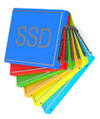
Lead Image © lightwise, 123R.com
Linux device mapper writecache
Kicking It Into Overdrive
The idea of block I/O caching isn't revolutionary, but it still is an extremely complex topic. Technically speaking, caching as a whole is complicated and a very difficult solution to implement. It all boils down to the I/O profile of the ecosystem or server on which it is being implemented. Before I dive right in, I want to take a step back, so you understand what I/O caching is and what it is intended to address.
What Is I/O Caching?
A computer cache is a component (typically leveraging some sort of performant memory) that temporarily stores data for current write and future read I/O requests. In the event of write operations, the data to be written is staged and will eventually be scheduled and flushed to the slower device intended to store it. As for read operations, the general idea is to read it from the slower device no more than once and maintain that data in memory for as long as it is still needed. Historically, operating systems have been designed to enable local (and volatile) random access memory (RAM) to act as this temporary cache. Although it performs at stellar speeds, it has its drawbacks:
- It is expensive.
- Capacities are small.
- More importantly, it is volatile. If power is removed from RAM, data is lost.
As unrealistic as it might seem, the ultimate goal is never to touch the slower device storing your data with either read or write I/O requests (Figure 1). Fortunately, other forms of performant, cheap, high-density, and persistent memory devices exist that do not perform as fast as RAM but that do still perform extremely well – enough so that I will demonstrate their use in the following exercise with noticeable results.
...Buy this article as PDF
(incl. VAT)
Buy ADMIN Magazine
Subscribe to our ADMIN Newsletters
Subscribe to our Linux Newsletters
Find Linux and Open Source Jobs
Most Popular
Support Our Work
ADMIN content is made possible with support from readers like you. Please consider contributing when you've found an article to be beneficial.







